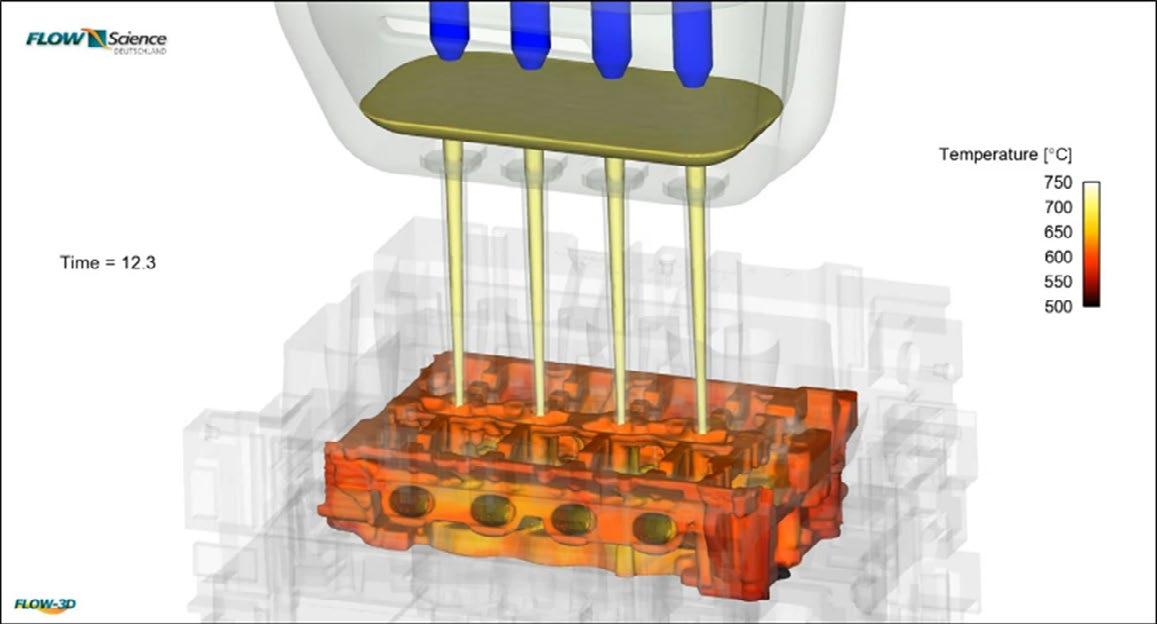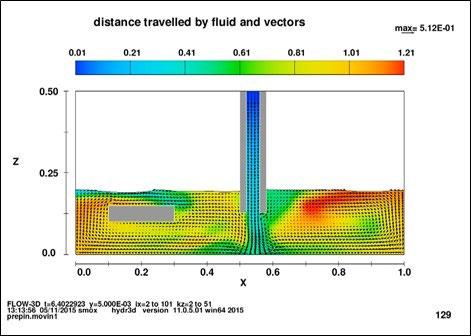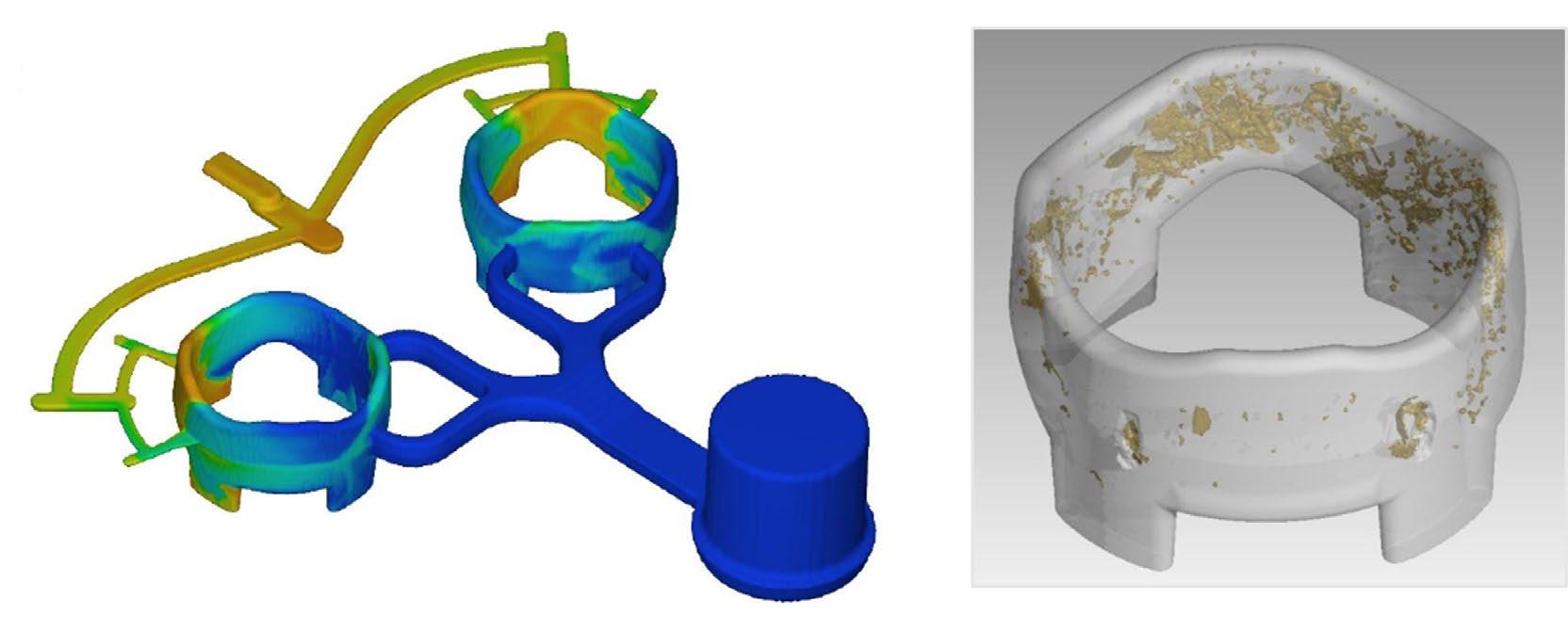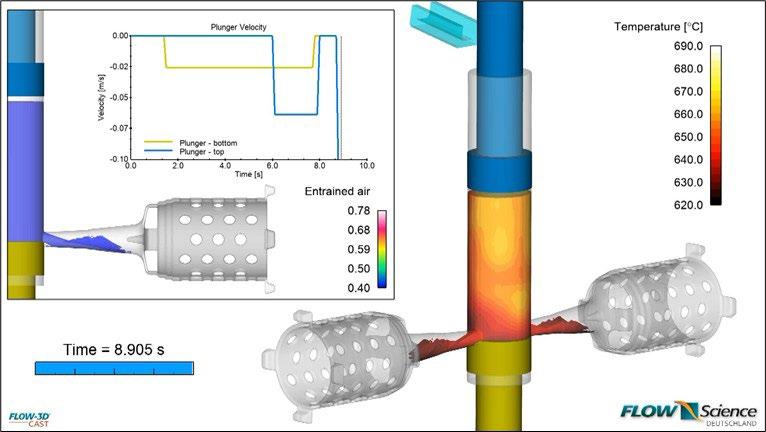
9 minute read
R. Pirovano......................................................................................................................................... pag
Simulation in support of the development of innovative and unconventional lightweight casting processes
R.Pirovano, M. Todte
Nowadays, foundry process simulations play a fundamental role to achieve a reduction of casting defects, an increase of the quality of the casting parts, an optimization of process stability and finally an improvement of the mechanical properties of the casting. To reach the highest quality levels new foundry processes have been proposed, to overcome the limits of the well-known classical approaches. Even if the advantages of a new method can be relevant, all its details must be carefully studied in a very preliminary stage, being the process itself, in its details, not completely known. For this reason, it is important to be able to study how to optimize the system to reach the desired performances, but also to highlight the challenges and the limitations of the new approach. A flexible simulation software allows to do it in a very effective way, analysing in detail the variation of the sensible variables in space and time and allowing to understand how to control and to calibrate the process parameters without the costs of an experimental evaluation. This presentation introduces application examples for four innovative casting and casting related processes where CFD simulations played an important role in their development and optimization: injector casting, laminar HPDC, salt cores and double plunger HPDC.
KEYWORDS:SIMULATION, CFD, INNOVATION, UNCONVENTIONAL PROCESSES, LIGHTWEIGHT CASTING;
INTRODUCTION: UNCONVENTIONAL APPROACHES Recently several innovations in the foundry industry have been shown, in the wake of the continuous research of increasing the product quality and reducing the scrap. In this direction a great work is done in optimizing, also using numerical optimization software, the existing processes, trying to find better and more controlled process parameters which minimize or maximize the desired performance, such as the amount of porosity and other defects or the mechanical properties of the casted part. Another, maybe more difficult, way to go towards a better result is through a more radical innovation, trying to develop and bring on the market new und unconventional approaches which can overcome the intrinsic limitations of the classical processes: the present work wants to focus on this last line, showing some of the most recent developments proposed in the lightweight casting industry. Raul Pirovano
XC Engineering Srl, Italy
Matthias Todte
Flow Science Deutschland, Germany
In the developing phase of new technologies, it is critical to be able to forecast in detail advantages, limitations, and challenges that the implementation of the idea will bring. In order to do it in the most efficient way, reducing the time and the costs related to an experimental phase, the intensive use of simulation software has been widely diffused in the last year: in fact, they allow to test easily different configurations, calibrate the process and analyze the outputs in detail in a very fast and effective way. The present work will show how a flexible CFD process simulation software was helpful in the development of four different innovative technologies.
INJECTOR CASTING Many engine components are produced with a gravity casting process. As for most of the casting part, the aim of the process is to reduce casting defects and increase the quality of the casting part and its mechanical properties, optimizing at the same time the process stability. Traditionally, different casting processes have been proposed: for instance, a top pouring method, where the feeders are filled with hot metal with consequent advantages for the shrinkage porosity location and the possibility to cool down the bottom plate. On the other hand, in this case there is a high risk for entraining air and oxides, du to the high velocities and the turbulence. On the opposite, a bottom pouring method minimize this risk, but the metal in the feeders is colder and it is not possible to cool down the bottom plate. Again, there is the possibility to make a tilt pouring, which improve these limitations but has high costs due to the machine used and additional risk of air entrainment due to the rotation. In order to combine the advantages of traditional processes and avoids their disadvantages, an innovative casting process with a moving feeding system has been developed: the metal is poured in the cast directly through thin injectors connected to a moving basin placed at the top of the casting part: the injectors at the beginning of the process are near the bottom of the part, reducing turbulence levels, air entrainment and oxides, but moving in the vertical direction they are able to fill directly the feeders with hot metal at the end of the filling phase. The bottom plate can be cooled, and there is no need to model pouring basin and gating system. The only limitation is that this process is not suitable for all casting parts, because of the placement of the injectors.
Fig.1 - Injector casting, global view and detail of the velocity field at the exit of one injector.
In the design of this system the simulation played a crucial role to understand the filling behavior and design the best shape and movement of the injectors, to get an optimal metal flow during the whole filling process, monitoring velocities, turbulence, temperature distribution and casting defects. Moreover, being able to move basin and injectors directly into the simulation, allowed to perfectly calibrate the process parameters such us the initial temperatures, the timings and the movement of basin and stopper, with a great reduction of the experimental effort.
LAMINAR HPDC Nowadays, the OEMs in the automotive industry, receive strong requirements for increased mechanical properties,

for instance for structural parts, and at the same time for weight reduction, associated to the production of high volumes in aluminum alloys, where HPDC is the most important process. One of the issues of achieve these requirements is that HPDC castings are often not suitable for heat treatment or welding, because of the presence of pores containing entrapped gas which would form blisters. To overcome this limitation an innovative “laminar HPDC” process, which is an HPDC done with a very low plunger velocity, has been tuned. The advantages are several: first, the process can be run on conventional HPDC machines, but obtaining a filling with basically no turbulence and a considerable reduction of air inclusions, allowing a longer intensification pressure phase due to the compact gating system, with a consequent reduction of shrink holes. Finally, the castings can be welded and undergo heat treatment.
Fig.2 - Gas porosity entrained during the filling during a laminar HPDC process.
Conversely, there are several challenges that need to be addressed. The gating system needs to be adapted, as well as the venting system, and there is a high risk for cold run due to long filling time. Then, an heavy heating of the die must be expected, with the adaptation of the thermal control system and the development of a dedicated spraying methodology. In setting up this new method, process simulations had a great importance, being able to provide to the engineer prior to go the real machine, with all the consequent risks, all the information regarding both the casting quality and the mold temperatures, allowing the precise calibration of all the process parameters.
SALT CORES To produce casting parts with a complex shape, often removable cores are adopted. Commonly sand cores are used but they have different limitations, for example in terms of surface finish and gas development. In the last years salt cores have been studied and brought to mass production because of the several advantages that they guarantee compared to the conventional sand cores. In fact, they can be removed without residues and risk of damage due to water solubility; there is no core gas development, so no porosity generation in an emission-free process; they produce high quality surface finishing, due to the very smooth core surface; they have a high stability against mechanical and thermal loads and they can increase the process robustness the casting quality. For these reasons, today they are used not only for the standard gravity casting applications, but also in HPDC. To use salt cores in a such demanding process as HPDC, several considerations must be done prior to go in production. First of all, it is important to understand if the core, once in the mold and subject to the high mechanical and thermal loads typical of the process, will be able to resist. Process simulation software can help, being able

to detect precisely stress and deformations on the core during the whole filling phase. Then, the production of salt core itself must be carefully investigated. There are various options: pressing, in gravity casting, in LPDC, in HPDC. Even in this case simulation software have been greatly helpful to understand the critical aspects of this new process. In fact, they can show in detail the filling and the solidification behaviour and allow to design and adapt gating and overflow system. Moreover, it is possible to optimize the process parameters and to keep in the correct consideration peculiar aspects, such as the residual stress and the high risk of shrink holes due to the very high density variation across the solidification.
Fig.3 - Salt core production with an HPDC process and porosity prediction.
DOUBLE PLUNGER HPDC To improve performances without increase excessively costs different techniques have been evaluated across the years. Among them, the idea of using two plungers during the same HPDC process has aroused a lot of interest and has been thoroughly investigated in order to grasp all its potential and criticalities. The idea of this innovative process is to put in series two plungers in the same vertical shot sleeve, which move in opposite directions. First, the bottom plunger is moved near the top of the shot sleeve, to reduce the drop height during the pouring of the metal in the sleeve itself, slowly moving downwards to increase the available space in the sleeve. Then, both plungers move downwards, and the top plunger reaches and block the open surface of the metal. When the bottom plunger reaches the gating system, a fast and well-coordinated motion of the two plungers injects at a high pressure the metal in the mold.
Fig.4 -Double plunger HPDC, beginning of the fast shot.


The possibility to work with a flexible simulate software, which allows to study several general moving objects at the same time, permitted to the developers of this concept to study the improvement in terms of casting quality of this process. Moreover, it allowed to perfectly calibrate the motion of the pistons, avoiding a premature compression of the metal and determining the perfect moment in which apply the fast shot. CONCLUSIONS Process simulation software are more and more common in the foundry industry, and they become even more useful when the development of a new process is investigated, allowing, with their accuracy, reliability, velocity and flexibility, to develop every detail of a concept highlighting both advantages and limitations in a very preliminary phase.
REFERENCES
[1] Todte M., Fent A., Lang H., Simulation in support of the development of innovative processes in the casting industry. Duesseldorf: GIFA Technical Forum 2015 [2] Wei G., A fixed-mesh method for general moving objects. Technical note FSI-05-TN73, August 2005, Flow Science ed. [3] FLOW-3D CAST v5.1 User’s manual. June 2020, Flow Science, ed.








